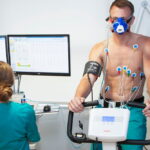The field of healthcare has seen remarkable advancements over the years and one such area that is changing the game is wearable medical devices. These are any apparatus or appliance which are worn on the body or incorporated into clothing and accessories to monitor and improve an existing health condition.
These devices use biosensors to collect biological data from a patient, including heart rate, blood pressure, sleep patterns, or blood sugar levels. These are typically used by individuals with diabetes, heart conditions, and hearing impairments, as well as those looking to follow their fitness performance.
The combined wearable technology market value was expected to be $28.3 billion and is expected to reach over $197 billion by 2030. This technology has revolutionized the way healthcare is now delivered and managed. This technology has been seamlessly integrated into our everyday lives and has revolutionized the way healthcare is now delivered and managed.
Applications of Wearable Healthcare Technology
You can now receive real-time health insights with this wearable technology and there is a demand for wearables to expand in the next few years. Some of the possible applications include:
Fitness and Wellness
There are around 67 million smart wearable device users in the US, making smartwatches and fitness trackers some of the most popular technology around. These are used to track physical activity and vital signs to help users maintain and improve their health and fitness goals. They can measure heart rate, steps taken, and other metrics like the number of calories burned.
Medical Treatment
Wearable electronic devices incorporate sensor optics to monitor vital signs and transmit biodata directly to healthcare providers. This technology has then been developed for use in medical health plans and equipment such as ECG monitors, insulin pumps, and hearing aids. These are useful for patients with chronic illnesses as they can provide alerts for timely medical attention.
Emerging Trends and Opportunities for the Future
There is a rising demand for wearables that is expected to continue over the next few years as consumer interest increases. By 2025, it is expected that smart wearable users will grow to 93.7 million with particular focus being placed on biosensor technology and textiles. This is to create smart clothing to create garments that monitor all sorts of health data and activity levels.
There is also the opportunity to revolutionize healthcare by using virtual reality tech that can be used in pain management, surgical training, and mental health treatment. Not only will this impact the way that patient’s pre-existing medical conditions are managed but can encourage others to make healthier lifestyle choices.
Read Also
- Why comprehensive health insurance with maternity is beneficial in the UAEWelcoming a child is a significant milestone in any family’s journey. As exciting as this chapter is, it also brings with it a fair share of responsibilities—especially when it comes to planning for healthcare costs. Health insurance is now mandatory in the UAE, but as with any type of insurance, the smallest requirement might not… Read more: Why comprehensive health insurance with maternity is beneficial in the UAE
- Modern Approaches to Adolescent Mental Health Treatment for Lasting RecoveryWith increasing numbers of teens experiencing emotional and behavioral health concerns, adolescent mental health treatment has become more essential than ever. Conditions such as anxiety, depression, trauma and mood instability are on the rise, and effective support must evolve with these growing needs. Today’s treatment models blend evidence-based therapy with flexible access and holistic care, giving… Read more: Modern Approaches to Adolescent Mental Health Treatment for Lasting Recovery
- How to Find a 5-Star Dentist Near YouChoosing a dentist is more than just finding someone who can clean your teeth. It’s about selecting a trusted partner in your long-term oral health. A 5-star dentist not only provides excellent clinical care but also delivers a positive patient experience, from the moment you walk in until the moment you leave. Whether you’re new… Read more: How to Find a 5-Star Dentist Near You
- Your Easy-Peasy Guide to Brewing Amazing MatchaHey there! So, you’ve heard all the buzz about matcha – that vibrant green powder that’s not just pretty but packed with good stuff? It can seem a little fancy and intimidating at first, but trust me, making a delicious cup at home is simpler than you think. Forget complicated ceremonies for now; let’s just… Read more: Your Easy-Peasy Guide to Brewing Amazing Matcha
- Embracing Holistic Wellness: Insights from a Lansing, MI Health CenterReframing Health: Moving Beyond Symptom Management Treating only symptoms often offers quick relief, yet long-term results stay out of reach. When care zeroes in on isolated complaints, the bigger picture, such as stress, behavior, or lifestyle, often gets missed. Research shows that whole-person care, which looks at physical, emotional, and environmental factors, yields better outcomes… Read more: Embracing Holistic Wellness: Insights from a Lansing, MI Health Center
- VO₂ Max Testing Explained: What It Is & Why It Matters for Your HealthVO₂ max sounds like a term reserved for elite athletes, but it’s among the most accurate measures of your lifetime and general condition. Moreover, it goes beyond performance. Monitoring your VO₂ max will help you to ascertain your body’s capacity to control stress, its oxygen consumption efficiency, and your internal ageing process. If you have… Read more: VO₂ Max Testing Explained: What It Is & Why It Matters for Your Health







